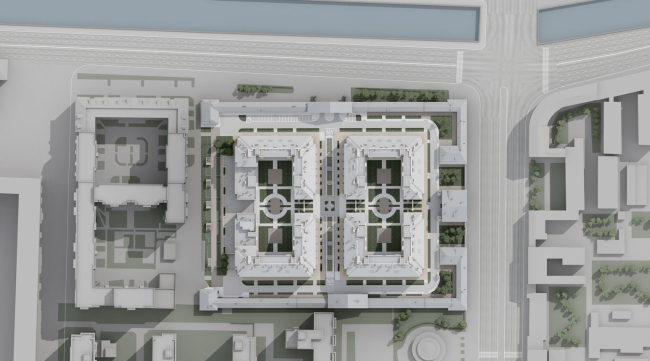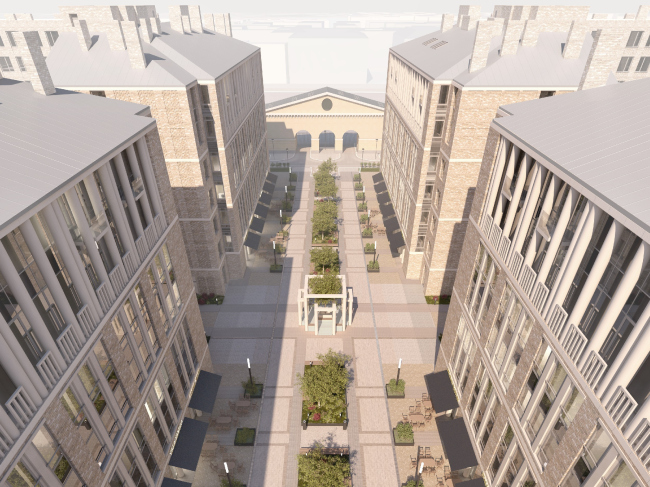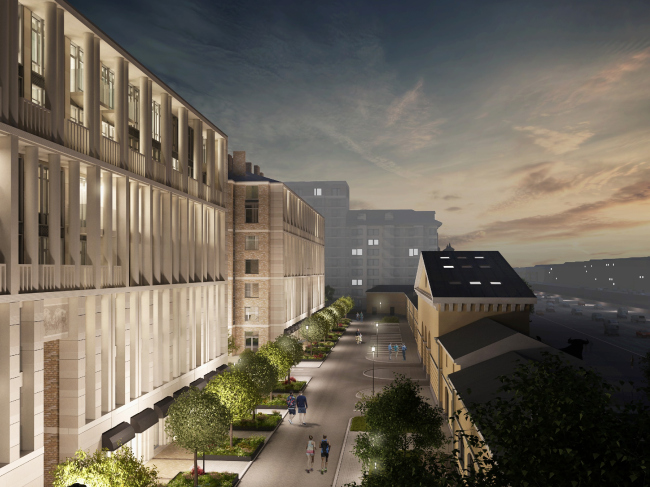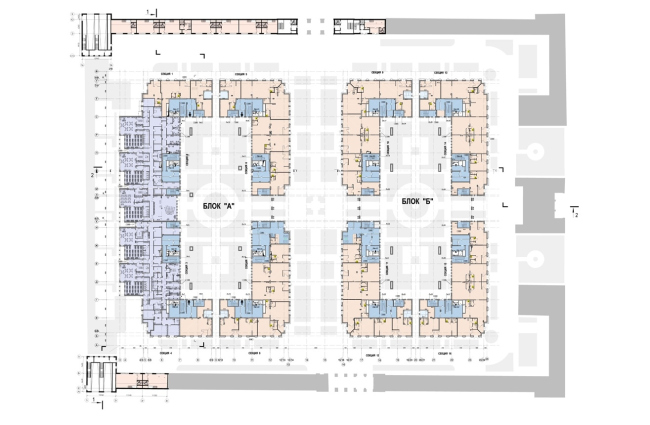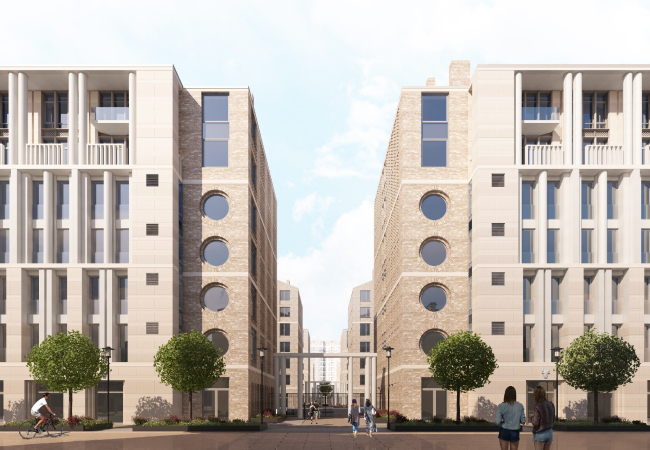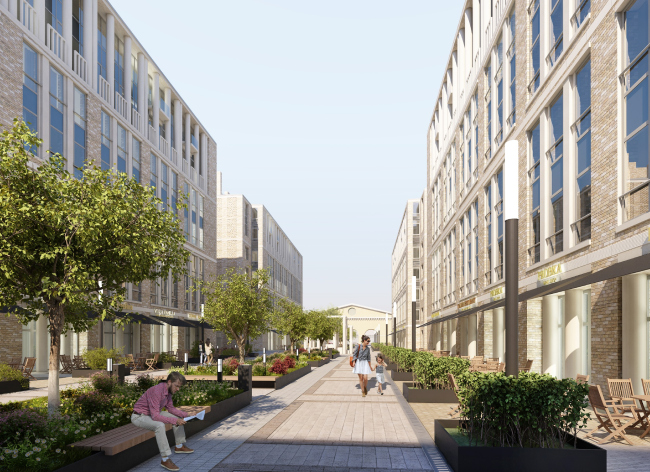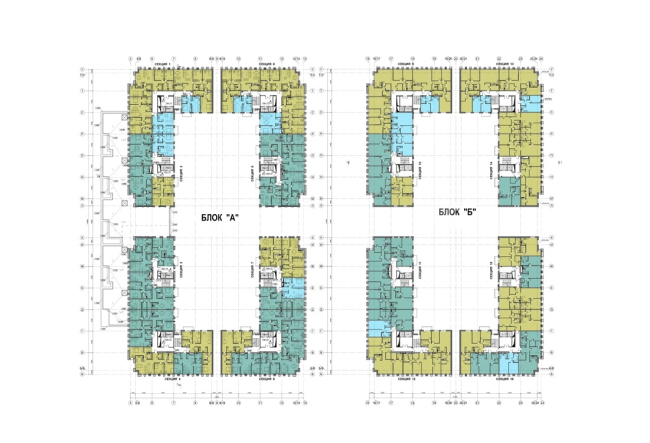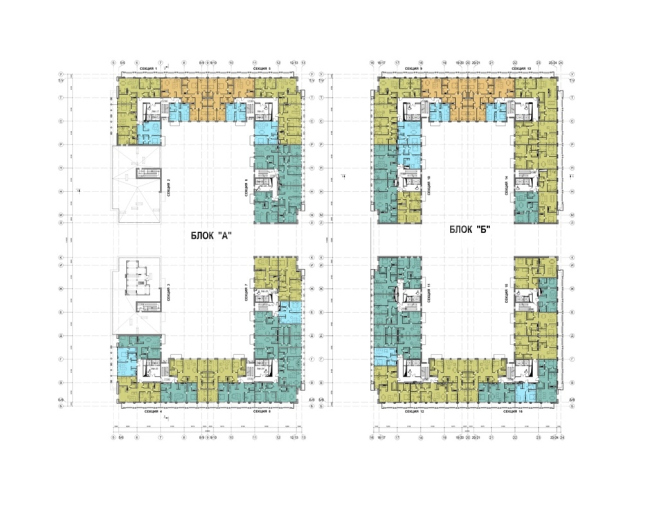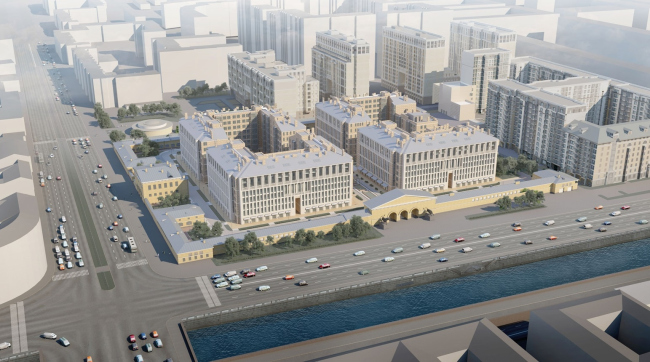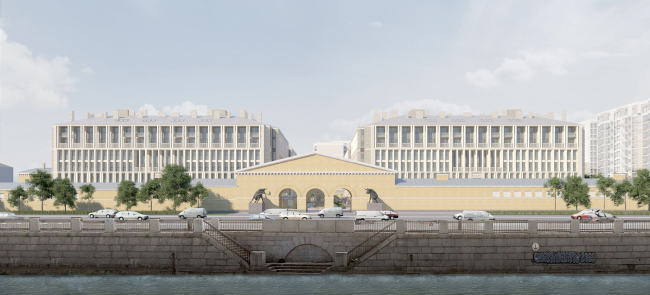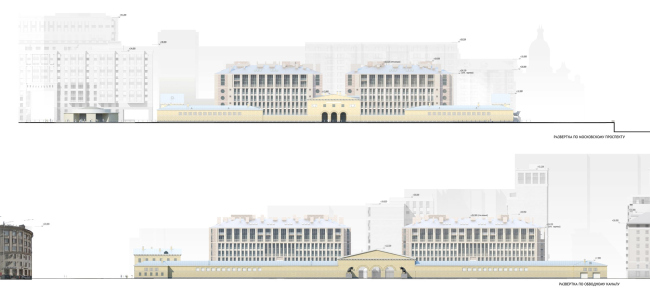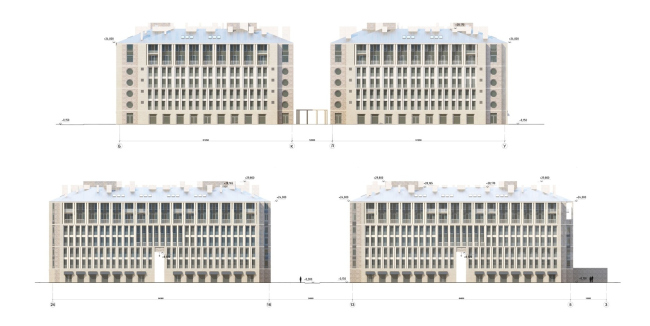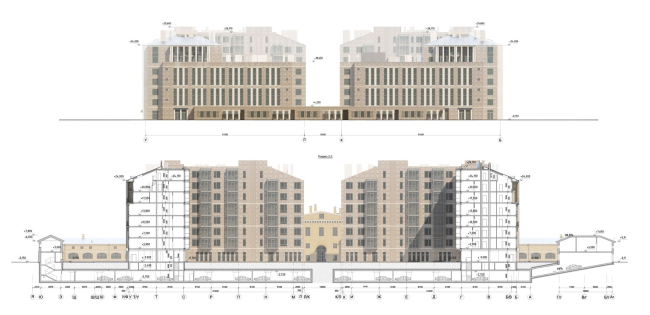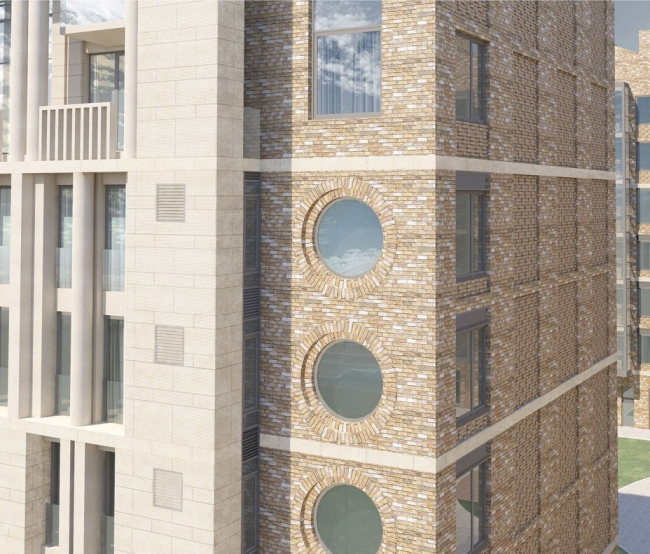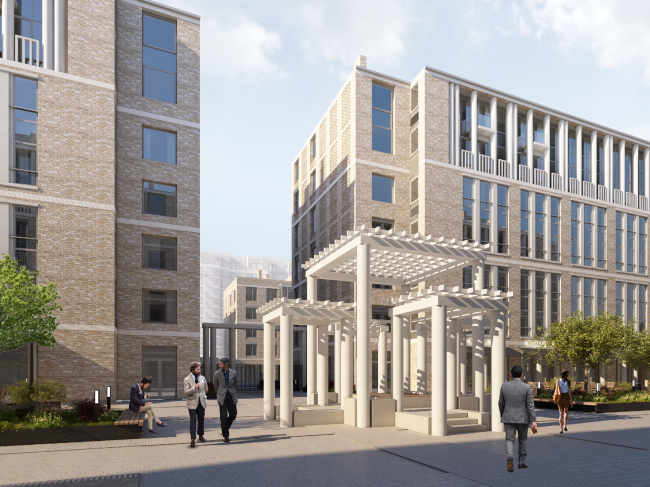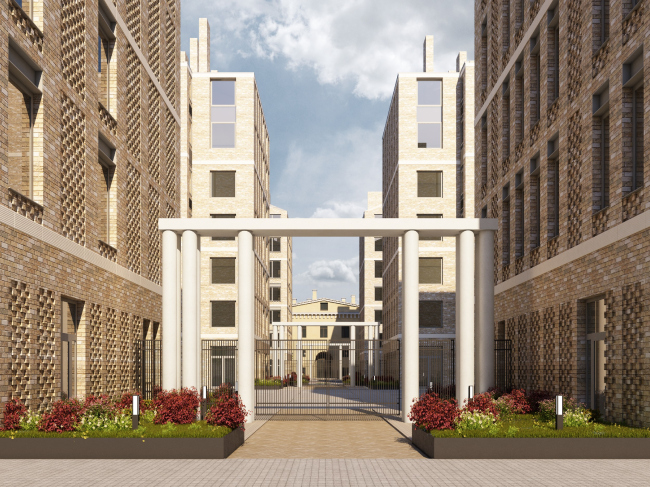|
Published on Archi.ru (https://archi.ru) |
|
| 01.08.2019 | |
|
In Search of Style |
|
|
Elena Petukhova |
|
| Architect: | |
| Nikita Yavein | |
| Studio: | |
| Company: | |
|
Looking for an answer to the eternal question about what Saint Petersburg style is about, Studio 44 combined contextual allusions, modern paraphrase of the northern neoclassical architecture, and an alternative approach to the city block construction. The result is large-scale and integral. A Legend About Architecture Photo of the main slaughterhouse. 1904Copyright: Studio 44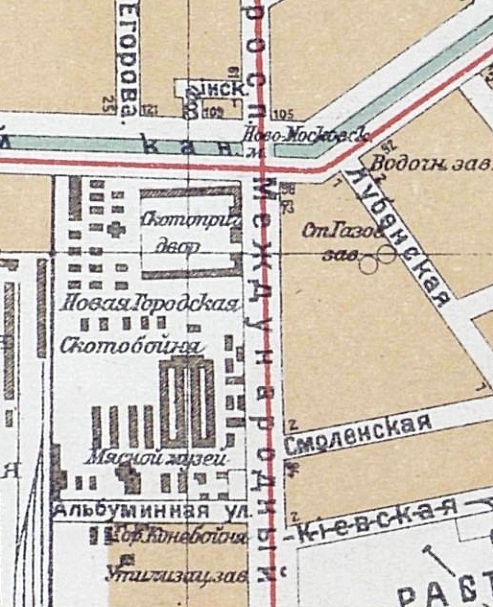 Fragment of the map of Saint Petersburg. 1925Copyright: Studio 44In the Soviet times, the “Cattle Yard” kept its appearance and partially even its function, in spite of the fact that the slaughterhouse and the stalls were moved out of town. The industrial revolution of the 1930’s brought about the reconstruction of the “bull’s rows” into production buildings of the Milk Factory (designed by Victor Tvelmeyer, Alexander Sokolov, and Ivan Fomin) that originally sported a constructivist appearance, which was later in the 1950’s to be radically changed into a more respectable type, more in line with the fashion for the Moscow version of “pseudo-Empire” (architect V.Matveev). The reconstruction of the mid-XX century affected the main buildings of the ensemble as well: the north wing of the historical building was changed, and in the same place, on the waterfront of the Bypass Channel, slightly more to the west of the original gate, a new checkpoint appeared. Nevertheless, neither the numerous reconstructions nor the hard life in the capacity of an industrial facility’s fence prevented the perimeter structure from getting a status of an architectural heritage site of the first third of the XIX century. Therefore, the perturbations of the “yard”, including the change of owners in the 1990’s, moving the production units of the “Petmol” milk factory outside the city in 2009, and developing this place as a venue for a commercial housing project in the 2010’s, took place, just as before, outside the historical perimeter set by the determined hand of Joseph Charlemagne, a devotee of Claude Nicolas Ledoux and Charles Cameron. Challenge 1 Studio 44 started working on the housing project, to be located on a segment of the territory of the “Petmol” milk factory with an area of 3.3 hectares, in 2016. The company had a few town planning and historical restriction that it used as starting points. All of the cultural heritage sites situated within the perimeter of the low-rise elongated buildings were, of course, to be preserved, the nearby protected area from 4 to 23 meters wide remaining clear of any construction. All the other structures inside the perimeter dating to the Soviet period had to go. Also, the architects were to take into account the height restrictions acting along the waterfront of the Bypass Channel and the Moscow avenue: construction not higher than 25 meters if 20 meters away from the red line and not higher than 30 meters if 50 meters away from the red line. For the rest of the territory, maximum elevation of 28 and 33 meters were allowed. Ultimately, what was left for the housing project to be built upon was a small chunk of land surrounded by a perimeter of historical walls with an impressive “legend” that posed a choice to the architects: either to accept the rules of the game or play against them. Studio 44 opted for the former. “When working on our future project, we adhere to the strict recipe that is dictated by the very town planning situation and the logic of its historical development. The last thing I want to do is to go against the spirit of the land site and try to impose my will upon it. It seems to me that when you go with the flow (in the best sense of this word) you can achieve more. And if – like in this specific instance – the land site has a prominent and rigorous perimeter, a history of its own and a structure that has survived all the perturbations, all you need to do is just follow it in order to ultimately get the best planning solution” – Nikita Yavein comments on his company’s attitude towards working with historical environment. The architects deliberately and consistently recreated the orthogonal planning structure, emphasizing its genetic connection to the military camps of Ancient Rome, the classic Empire style architectural ensembles, and, of course, the original plan of the Cattle Yard. The multifaceted legend that the architects ultimately got allowed them to develop the volumetric solution of the complex, creatively combining different techniques and methods of working with the structure and a wide range of stylistic references. The housing complex on the territory of Petmol FactoryCopyright: Studio 44A City with an Open Gate or The Power of Orthogonal Planning The territory of the housing complex is traversed by two perpendicular streets, each of which is essentially a compositional axis, the main role being played by the north-south one. The broad promenade is designed as a boulevard that runs from the entrance arch that stands closer to the bypass channel, kept in the style of the former milk factory up to the historical buildings. Unfortunately, the south gate is slightly mismatched with the axis but this does not affect the overall composition of the boulevard in any way; there are rows of flowerbeds with decorative trees and openwork pergolas running in the middle of it. The perpendicular axis, running westward from the Moskovsky Avenue and the main historical building, pierces the two main blocks A and B leaving broad passages in them. The architects decided not to cover them with arches and limit themselves to decorative portals stylized as a simplified orderly system. The housing complex on the territory of Petmol FactoryCopyright: Studio 44The two main residential blocks of the form an open square 115x65 meters. The blocks are virtually identical, but for one exception: the first floor of the east façade of Block A has a kindergarten inbuilt into it, because of which the architects had to sacrifice the final break of the perimeter and the complete identity with the Ancient Roman prototype, as well as the end-to-end passage from the Moskovsky Avenue to the new housing complexes in the depth of the city block, which can be most likely regarded as a plus for the future residents who will hardly put up with the constant traffic on the decumanus. The housing complex on the territory of Petmol FactoryCopyright: Studio 44The housing complex on the territory of Petmol FactoryCopyright: Studio 44In addition to the break in the “east-to-west” axis, each unit has two extra rectangular arched passages two stories high that mark the symmetry axis running from north to south, and connecting the inner yards 82x32 meters to the outside pedestrian streets that occupy the protection area between the main buildings and the historical perimeter. The housing complex on the territory of Petmol Factory. The floor plan at elevation +0,000Copyright: Studio 44The housing complex on the territory of Petmol FactoryCopyright: Studio 44The housing complex on the territory of Petmol FactoryCopyright: Studio 44The inside yards are completely vehicle-free thanks to the underground parking garage that occupies virtually the entire construction blueprint inside the protected heritage site area. The housing complex on the territory of Petmol Factory. Plan of the 2nd floor at elevation +3,900,+7,200Copyright: Studio 44The housing complex on the territory of Petmol Factory. Plan of the 2nd floor at elevation +17,550, +20,850Copyright: Studio 44As a result, the architects are getting a clear-cut orthogonal system, in which the clusters of buildings, new and historical ones alike, alternate with public spaces that have in them additional markers of the axes and cardinal points: arches, portals, and rows of trees, which will help a resident or a visitor who got lost in this system to get their bearings without having to study the moss on trees or looking for the North Star in the overcast skies of Saint Petersburg. The adamant planning logic and the power of orthogonal lines helped the structure (which was proposed in the very beginning of the project) to outlive two developers who clearly appreciated not so much its classical purity and connection with historical prototypes as the output of useful floor space, the prospects of renting out the public bottom floors, and the solved-in-advance problem of in-block security. The last consideration, dictated by the introverted character of the resulting structure, which is essentially “a city within a city” with perimeter residential buildings inscribed inside the perimeter of the historical walls, is slightly at odds with the idea of bustling retail and highly developed service infrastructure on the inner pedestrian streets – but only time will tell how hospitable the future complex will be, and whether or not will prevail the ideas of the architects who call this project “a city with a gate”, yet succumbing to the residents’ one big collective interest in privacy. Challenge 2 The method of designing based on genius loci of the land site predetermined the architects’ approach towards the stylistic solution for the future housing complex. The presence of classical monuments of architecture of its very own, the constructivist transformation that this ensemble underwent in the 1930’s, and, finally, the vicinity of the “pseudo-neo-classics” of the Moskovsky Avenue yielded a lot of room for creative experiments. The image of the complex was to become a well-balanced alloy of three architectural traditions of Saint Petersburg, which made finding the solution for the task all the more interesting for the architects of Studio 44, and turned the result of their work, to a certain extent, a manifesto of their interpretation of “Saint Petersburg style”, which has been the subject of discussion in the north capital of the nation for decades. And finding the solution for the problem became yet another challenge for the creative team. Nikita Yavein comments on the problem of “Saint Petersburg style” in the following way: “Unfortunately, the topic of forming the modern architectural language that would at the same time be suitable for building in the center of our city, is discussed in the expert community rather chaotically and, as a rule, only in connection with questionable projects, in which the very notion of “Saint Petersburg style” is shamelessly used to cover up professional mistake or downright incompetence. What never ceases to amaze me is the fact that the specimen most often used for this interpretation is the architecture of the 1950’s that my father used to call “pseudo-neo-classics of the cult of personality epoch”, or, to be more precise, the variation of it that was built here – luckily, only at a few places – as a copy of Moscow’s postwar construction. And Saint Petersburg, mind, is all about quite a different neoclassical tradition, which can be traced at the examples of buildings designed by Evgeny Levinson, and, to some extent, Ivan Fomin. They are essentially the geometric version of neoclassicism, in which large volumes of the simple shapes are solved in accordance with the same orderly fundamentals as the classical monuments. It was this specific approach that we took as the basis for the housing project on the Moskovsky Avenue, where we tried to show just what “Saint Petersburg style” means to us. We wanted to make sure that the architecture of the new buildings inherited the genetic code of its predecessors – both the Empire of the 1830’s and the Empire of the 1930-50’s, becoming the harmonious connecting link between them”. The housing complex on the territory of Petmol FactoryCopyright: Studio 44The housing complex on the territory of Petmol FactoryCopyright: Studio 44The Outpost of Style Giving shape to the four monumental blocks that form the residential units became the natural development of the set planning system and the principles of forming the new architectural language. Refraining from using large-scale plastique fracturing, such as projections or bay windows, allowed the architects to focus the observer’s whole attention on the artistic expressiveness and tectonics, as well as the subtleties and the though-out proportions of the façade structure, looking like a simplified three-tier orderly system that is crowned by a double attic floor with a colonnade fringing the perimeter of the resulting terrace. The floors below are divided into three levels. The first one, one story high, is meant for the service and retail infrastructure and is not decorated in any way. The next levels are grouped by two floors, and differ in the number and shape of their pilasters that cover every other tier. On the bottom level, they are doubled and rectangular on the plan, on the top level – single and semicircular. The structure is designed in an ostentatiously laconic way, without capitels, bases, and other canonic elements of the orderly set. Refraining from using them is yet another characteristic feature of the “Saint Petersburg style” from Studio 44 whose priority is all about proportions and tectonics, and not decor or its imitation. The housing complex on the territory of Petmol FactoryCopyright: Studio 44The housing complex on the territory of Petmol FactoryCopyright: Studio 44The housing complex on the territory of Petmol FactoryCopyright: Studio 44The outside façades are clad in natural stone of a light beige tone – but not all of them. On the corners, the stone orderly structures stop short, opening to one’s gaze brick walls sunken one meter inside with simple round windows – an unexpected yet a thought-out courtesy to the constructivist project of the milk factory – and slender white belts that mark the intermediate floors. A very curious postmodernist thing that demonstrates to the keen observer just how conditional the whole grand façade and the orderly system are, which is propped up against a simple brick building very much like a theater decoration. Which is basically the truth. The housing complex on the territory of Petmol FactoryCopyright: Studio 44The housing complex on the territory of Petmol FactoryCopyright: Studio 44The housing complex on the territory of Petmol FactoryCopyright: Studio 44The housing complex on the territory of Petmol FactoryCopyright: Studio 44It comes as no surprise that the façades, both on the yard side, and the ones that face the axial promenades, are designed in ashlar brick, while the stone orderly echoes on them on the form of belts and pilasters are nothing more than a reminder of the solemn array and rhythm of their beautiful counterparts that work as the “face” of the housing project. Nevertheless, the structure that was set from the outside is kept here as well. It is only the manner of its presentation that changes. Besides, the already-mentioned decorative stone “guests” are added by purely brick techniques, such as alternating of structured and smooth brickwork, reminding us about the pilasters. ***
As a result, the housing project produces a very integral impression. The expressiveness of the architects’ signature technique and the reserved manner of its interpretation help to form a harmonious architectural ensemble. The monolith volumes, clad in orderly structures and rising over the historical walls, in spite of their seeming compactness (especially when viewed against the background of the giant high-rises towering in the distance, about 60 meters high) can still claim the status of a full-fledged architectural landmark. The housing complex, like an island or, rather, an outpost, marks the dividing line between the old and the new city, connecting the traditional and the new architecture of Saint Petersburg. |
|


